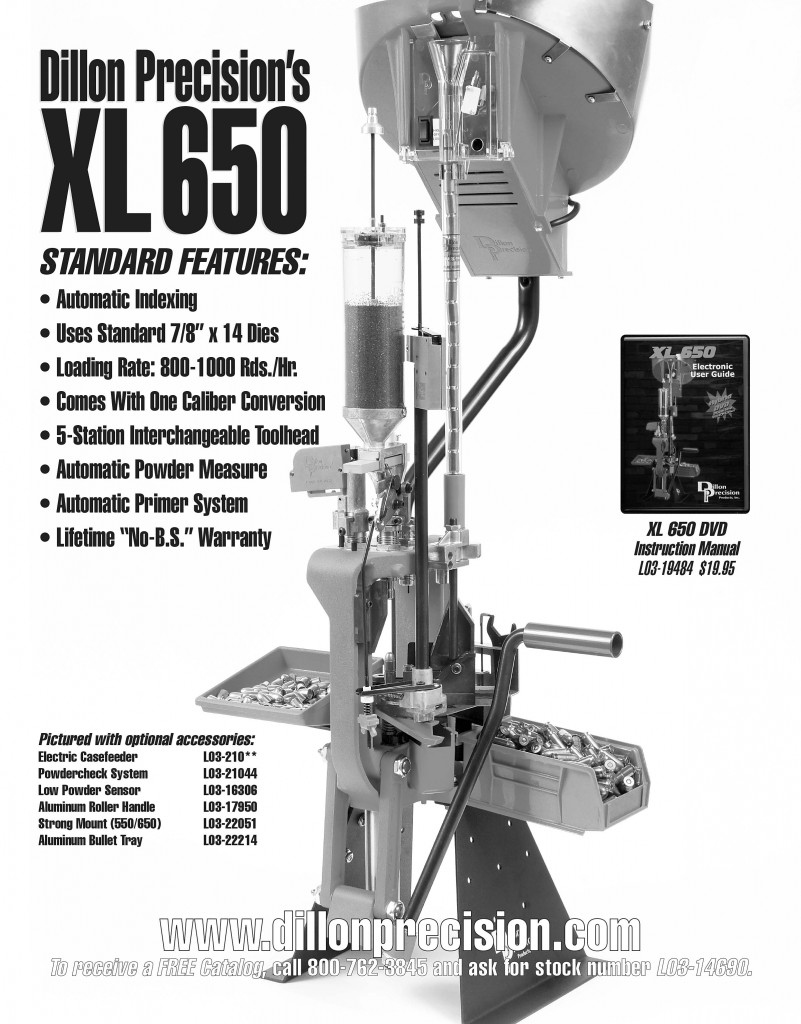by Larry S. Sterett | Contributing Editor
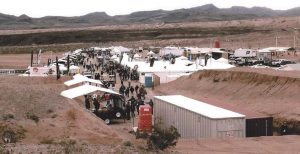
A view of the lower portion of Media/Industry Day that precedes the SHOT Show shown in operation at the huge Boulder City Gun Club. Some of the firing butts are to the left, others to the right and shotgun ranges were further up the hill behind this view.
The 2016 SHOT Show was a celebration of anniversaries, or so it appeared. The Show itself reached the 37-year mark, but Remington Arms is celebrating 200 years (1816-2016), Winchester is celebrating 150 years (1866-2016), and Fiocchi is only a decade behind with 140 years (1876-2016), as also is Camillus Knives (1876-2016.)
Several other firms were noting lesser anniversaries, such as Williams Gun Sight with 90 years. On the Range, and Predator International LLC marked 15 years (2001-2016). It also seemed to be a show with more emphasis on the color pink as in pink camo, pink grips, etc. Even Smith & Wesson introduced the firm’s M&P 15-22 Sport rifle in a Muddy Girl Camo pink version, and they were not alone.
It is not unusual to see foreign firms displaying their wares at the show, but these tend to be companies from the UK, Spain, Europe, the Asiatic region, or Japan. One small exhibit new to this shooter was the Yong Sheng HUA Steel Ball Factory from the Shandong Province in China. The firm apparently does not load ammunition, but manufactures steel shot sized for loading shotshells, for use in BB guns or air rifles, and larger sizes for use in sling shots. The shot is produced zinc-coated or copper-coated, annealed or not annealed. For air rifle/pistol use the standard is .177-inch (4.5mm), while six slingshot sizes, from 6.5 mm to 12 mm are available.
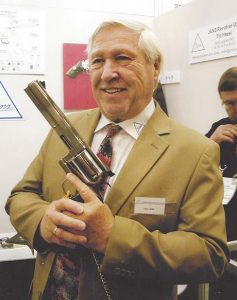
Herr Uwe Janz, the man behind the big German-manufactured Janz Type S-EM-S revolver that offers easily interchangeable barrels and calibers.
In a show seemingly dominated by AR-15 type rifles and accessories, new ammunition manufacturers, knives, and suppressors, there were a number of new interesting, or innovative items. One of these was the German-manufactured Janz Revolver, Types S + EM-S. The Janz features a quick-change caliber system, from .22 Long Rifle rimfire to .454 Casull centerfire on one frame. Changing barrel lengths on a revolver is not new. Dan Wesson revolvers had this capability when introduced some four decades ago, but it was only the barrels. Changing calibers in an autoloading pistol is not new; Colt, Smith & Wesson, H&K, and a Tokarev version all had models which could be multi-caliber. In the single shot pistol field the Thompson/Center Contender/Encore models were probably the leader in multiple-caliber changeability. (There were other single shot pistols with switch barrel ability, such as the Merrill Sportsman, but usually only the barrel was changed.) Changing calibers in a revolver requires a cylinder change also, and this has been a past problem.
The Janz is available in three frame sizes—EM, E, and MA. The EM frame can be fitted with cylinders and barrels from .22 LR to the .44 Remington Magnum, with barrel lengths from 2½” to 12”. The E frame will accept the same barrel lengths, and cylinders from the .22 LR to the .454 Casull. The MA frame accepts barrels from 4” to 12” in length, but only .460 S&W or .500 S&W Magnum cylinders. Overall, ten barrel lengths are available, with compensators available for all but the 2½” barrel. For the quick-change frames seven cylinders are available:-.22 rimfire, .38 Special, .357 Magnum, .44 Magnum, .45 Colt, .45 Winchester Magnum, and .454 Casull. Cylinder capacity varies from five rounds in the .454 Casull, six rounds in the .44 Magnum, .45 Colt, and .45 Winchester Magnum, seven rounds in the .38 Special and .357 Magnum, and eight rounds in the .22 rimfire.
The British exhibits are usually grouped together in specific areas at the SHOT Show, as usually are the German, Italian, and Spanish exhibits. This year the Eley shotshells were knowable for not being visible, although the Eley rimfire ammunition line was promoted. New, at least to this shooter, was the showing of a new Cogswell & Harrison (C&H) line of shotguns and rifles. The name is not new, having been around since May of 1770 on New Kent Road in London. Today, the C & H line is produced just 20 miles north of 168 Piccadilly, London.
Currently the C&H line includes side/side and over/under shotguns, side lock and box lock, a new Windsor line of over/under game and sporting shotguns, and the Certus line of bolt-action centerfire and rimfire rifles. (The Certus name on rifles has been around since at least 1900.) The current Certus rifles include the centerfire with 20” barrel, choice of metal finish—blued or stainless—synthetic stock, detachable three-round box magazine, and a choice of 11 chamberings, from .222 Remington to 8mm Mauser. The largest non-metric chambering is the 30-06. Three other metrics available are 6.5x55mm, 7x57mm, and 7x64mm.
Williams Gun Sight is known for its line of sights, scope mounts, and gunsmithing tools, but the firm also offers complete gunsmithing for dealers and individuals. Handguns, rifles, or shotguns, Williams can do the job for you, even build a new custom rifle, if you so desire. New for 2016 in the sight line are ten Firesight open sights for a number of arms from the AR-15 to Glock, Ruger, and Taurus handguns. Hunters using shotguns with rifled slugs for deer season may want to check out the new Universal “Ghost Ring” Firesight. It mounts on the ventilated rib of the shotgun, and installation requires no gunsmithing. It’s said to permit faster target acquisition than regular sights, with excellent low light performance.
Smith & Wesson introduced 17 new versions, of which one—the SW22 Victory—is a new model handgun. All but three are handguns, which makes sense since this is basically what S&W is known for producing. No new revolver models or versions, but autoloaders from .22 rimfire to the 45 ACP. Magazine capacities vary from six rounds (380 ACP) to 17 rounds (9mm), depending on the model and caliber, with the 9mm and 40 S&W models featuring the larger capacities.
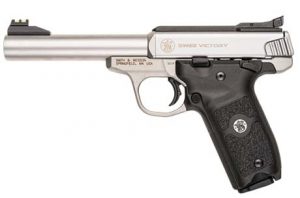
The new, modular S&W Victory rimfire .22 pistol.
The new S&W Victory rimfire .22 pistol is a modular, metal-framed target pistol with fiber optic front and rear sights. Available in three versions, including one with a threaded muzzle and one with a Kryptek Highlander camo finish, the Victory has a ten-round magazine, and a barrel length of 5.5 inches. With its modular design it reminds this shooter of one of final High-Standard take-down designs prior to the Leisure Group days. It is not the same, of course, and it comes with a Picatinny-type rail for optic sight mounting.
Camillus was promoting their Carbonitride Titanium and Titanium Bonded knife blades, plus a Made in USA line of fixed blade knives, including a 100th Anniversary edition of the Western Skinner. The Carbonitride treated knives are stated to be up to 10X harder than untreated steel and thus the blades stay sharper longer. (The Titanium Bonded knife blades are said to be 3X harder than regular steel blades.) The Anniversary Western Skinner is a bit upgraded from the original, but it is still 9.25” long with a hollow-ground 4.75” blade. However, the stocks on the handles are of durable brown canvas Micarta. A saddle-skirting leather sheath with belt loop accompanies the Skinner.
Century Arms, which has been in business for 50 years, was promoting the firm’s three brand lines of products. These include the Red Army Standard (RAS), Canik USA, and Century Battle Gear. The Red Army line includes 100% American-made AK-type rifles and pistols chambered for the 7.62x39mm cartridges, and steel-cased ammunition manufactured in Russia, Poland, Bosnia, Herzegovina or Romania. The RAS calibers include 7.62x39mm, 5.45x39mm, 7.62x25mm Tokarev, 9x18mm Makarov, and 7.62x54R in 180-round range packs, or by the case.
The late John Nosler started his business back in 1948 producing his unique Partition bullet, featuring an H-shaped copper jacket with lead cores at the front and rear. Regular jacketed bullets would sometimes shed their jackets and fail to penetrate sufficiently. Not so with the Nosler Partition. The forward portion expanded while the rear portion remained intact to continue penetration.
In 2007 the Nosler Model 48 rifle was introduced and named Best of the Year by Field & Stream magazine. Two years later the Nosler line of loaded ammunition was introduced. It only follows there should be specific Nosler cartridges in the ammunition line, and in 2014 the 26 Nosler was introduced. In 2015 the 28 Nosler and 30 Nosler cartridges were introduced with the latter more a 2016 coup.
The current three Nosler cartridges share the same non-belted 404 Jeffery case as a starting point. They have a maximum overall loaded cartridge length of 3.340” meaning they can function in an action designed for 30-06 Springfield length cartridges. This permits a lighter weight rifle and a shorter bolt throw for a faster repeat shot when needed. All three current Nosler cartridges have velocities exceeding 3,000 fps at the muzzle, and the 26 Nosler loaded with a 120 grain E-Tip bullet moves out at 3,450 fps.
In 2016 the Nosler firm not only has an extensive line of bullets, rifles, and loaded ammunition, but ready-to-load empty brass for 55 different cartridges from the 17 Remington to the 375 H & H Magnum. Nosler brass features deburred flashholes, deburred and chamfered case necks, and full-sizing. It can’t get much better.
This shooter has been a Mossberg fan since he obtained his bolt action 26-shot (Shorts) Model 46B many moons ago. For 2016 the firm introduced six new Model 590/590A1 pump action shotguns, in addition to more than a dozen new Model 500 versions. Among the latter is the 500 ATI Scorpion, a six-shot 12-gauge version with 18+-inch barrel, heat shield, 6-position TactLite stock with adjustable cheek riser and pistol grip, add-a-shell side saddle, and receiver and heat shield rail components.
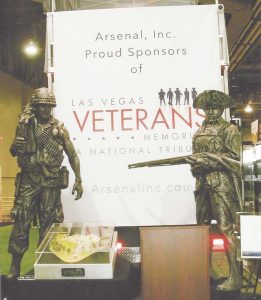
Arsenal Inc. (aresenalinc.com) had a nice bronze memorial tribute to veterans, from the Revolutionary War (on right) to the modern era (on the left).
Other Mossberg additions include new versions to the 510, 535 ATS and, 835 pump action lines, the 930, 935, and SA-20 autoloading shotgun lines. There are a couple of new versions of the bolt action Patriot rifle line, and three new AR-style MMR rifles. The MMR rifles have barrel lengths of just over 16 inches with fixed A2 muzzle brakes, are chambered for the 5.56mm NATO cartridge, and have Picatinny rail mounted adjustable sights. Two models feature a six-position adjustable butt stock; one has a fixed stock to be California compliant.
Lehigh Defense bills itself as “The World’s Most Innovative Projectile Manufacturer,” and it may be just that. The firm currently offers 11 bullet technologies suitable for loading assorted popular caliber handgun and rifle cartridges. Machined from solid copper or copper-alloy, some with alloy nose or tip inserts, the bullets are capable of achieving what they were designed to achieve—expansion, penetration, or controlled fracturing. Available designs include the Xtreme Penetrator, Xtreme Defense, Extreme Cavitator, Maximum Expansion, Subsonic Maximum Expansion, Controlled Fracturing, Subsonic Controlled Fracturing, Controlled Chaos, Multiple Projectile, and Match Solid.
In a Multiple Projectile round the projectiles began to separate in flight to create multiple hits, while the lead projectile will follow the point-of-aim trajectory. The Xtreme Penetrator projectile has peripheral flutes on the nose to compress the hydraulic energy into four jets creating a wound cavity similar to an expanding hollow point, but without limited penetration. The Chaos projectile uses hydraulic pressure to function. When the pressure exceeds the hoop strength of the thinner nose portion it fractures, followed by the thicker nose portion, leaving the base to continue penetrating. Other Lehigh projectile designs feature innovative functions.
Leigh Defense, coupled with Millennium Manufacturing, also produces M1911 and high precision AR components, plus muzzle devices including advanced suppressor designs. As the firm stresses, their products are made in America with Pride.
Crimson Trace has been turning out top-quality laser sighting equipment for more than a score of years, and for 2016 they have introduced the world’s first wireless laser and white light system—the LiNQ. Currently the LiNQ is available to fit any AR-type sporting rifle with M1913 Picatinny, or similar type, rail measuring at least 2¾ inches in length. The green laser and 300-Lumen LED white light unit, housed in a water resistant aluminum body, fits on the lower rail behind the muzzle. Control is via a waterproof polymer replacement pistol grip. Four modes of operation are possible—laser only, laser and light, light only, and laser and strobe light. Battery life is approximately two hours, depending on mode of operation.
Fiocchi of America has several new products for 2016. In addition to some loads and packaging, Fiocchi has teamed with Benelli USA to produce two 28-gauge 3” loads for the new Benelli ETHOS 28-gauge shotgun featuring Progressive Control. These 3” 28-gauge Golden Pheasant loads are available with an ounce of lead shot at 1,300 fps, and a heavier 1-1/16 ounce load of nickel-plated lead shot at 1,200 fps.
Rimfire shooters will appreciate the 22LRTTSP cartridges loaded with a round nose lead bullet to 1,115 fps. Although not new, Fiocchi is one of the few firms to load the rimfire 9mm Flobert cartridge for those shooters who have a 9mm Flobert shotgun. Available with a choice of size 6, 7½, 8 or 9 shot, these brass-cased shotshells are loaded to a velocity of 600 fps, and are packaged 50 cartridges per box.
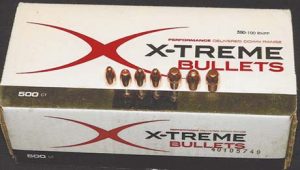
X-Treme bullets for handloading are copper-plated lead. Most calibers are round nose or with flat tips or points, and are available in calibers from .380 to .50. The second bullet from the left among the representative bullets above is a .429 hollowpoint, while the ones on the far right—new 300-grain .458 and third from the right have cannelures.
Suitable loading components are a necessity if you handload any ammunition, and XTreme Bullets must have given out tons of their products at the 2016 Show, based on the empty boxes seen being moved away from their exhibit. The firm, which is a company of HMT (Howell Munitions & Technology), produces copper plated lead bullets in calibers .380 to .50 in a variety of weights and nose profiles, and rifle bullets in .22, .30 and .458 sizes. They also produce hard cast lead bullets in more than 20 types from .32 to .45, along with six rifle designs from .30 to .45-70. New for 2016 was the 300-grain copper plated .458 with a flat point round nose, and a 62-grain full metal jacket, with cannelure, .22 in the rifle line. In the handgun line, a 350-grain round nose flat point has been added.
Some five decades ago the local high school used to have card shoots for shotguns to earn money for their Senior Class Trip. The cards, each with a center X, were set up on posts at 25 yards and each shooter having paid a fee was issued one shell. On command, the shooter fired his or her one shell at the card. The signed cards were retrieved and the card with a pellet in the center of the X, or closest to it, was declared the winner. (Shoot-offs were required, but seldom necessary, in case of ties.) The prize was usually a live goose or turkey, and being a champion trap shooter was no guarantee of a win, as a local champ discovered. The standard gauge was the 12, although if a shooter wanted to use a 16, 20, or even a .410-bore it was permitted. (Not necessarily wise, due to smaller shot load, but permitted.)
Today, card shooting is becoming popular again, but it is definitely more competitive. Using a custom 12-gauge shotgun and shooting at a card or paper target from 17 to 40 yards away, the winner may win money, meat, or some other equally desirable prize, but it won’t be easy. Judging or scoring is determined by knockout, taking out most of the dot on the card or by getting closest to the X. In the highest level of this sport, “Outlaw,” this could mean 15+ consecutive knockouts to win a round, and if you miss, you’re out.
Most modern card shoots are comprised of 5-20 rounds, with entry costs from $2 to $50, depending on the prize. (The prize could be small packs of meat, a side of beef, or dinero from a double sawbuck up to $2,500 per round.) Smaller shoots may draw an average of two to four dozen shooters, while a big, highly advertised shoot may draw 100 or more shooters. Most events are held on a regular basis on a weekly or monthly basis, and income helps keep the clubs operating. (The website www.turkeyshoot.net has an abundant amount of information as well as a community forum from contributors who are actively involved in the sport.)
According to information obtained at the 2016 Show card or target shooting currently accounts for sales of well over 1.5 million shotshells per year. That doesn’t include shotguns, optics, accessories to help increase the chance of a win. In 2016, Gunworks Research & Development, LLC, of Ohio teamed up with Ithaca Gun Company to manufacture the 12-gauge Ithaca/Gunworks Pro Modified M37 strictly for Outlaw Competition. It’s a monster of a shotgun, and the “Red Monster” viewed should be capable of winning many card shoots.
In the middle of the last century the High Standard Mfg. Company produced an excellent line of autoloading pistols, revolvers, rimfire rifles and pump and autoloading shotguns. After becoming part of the Leisure Group for a few years, the firm folded and the High Standard name and a few of the pistol designs are now part of a Texas-based firm. An entirely different firm is the New Britain, CT, Standard Mfg. The Standard pump action, double barrel DP-12 shotgun was introduced last year and drew a lot of attention. This year Standard has two new 12-gauge semi-auto shotguns—the SKO-12 and the SKO-BULL. Both new shotguns feature detachable box magazines, but the SKO-12 resembles an AR with six-position buttstock, pistol grip, raised sights, etc. The SKO-BULL is a bullpup design with the magazine to the rear of the pistol grip and the cheek piece directly above the magazine housing. Both models are streamlined compared to the USAS-12 available a couple of decades back, and lighter in weight. Detachable box magazines for 12-gauge shotshells allow for rapid changing of loads, but tend toward being unwieldy if the capacity is much over eight rounds. No doubt Pro Mag, or another firm, will introduce a higher-capacity drum magazine for the SKO-12 if it becomes popular enough.
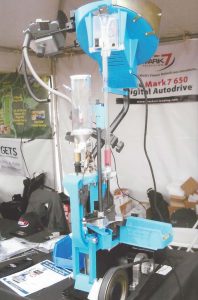
The belt-driven Mark 7 Digital 650 Autodrive for Dillon Precision presses, shown at the lower right in operation.
Dillon Precision’s blue progressive loading presses are well known for their quality. Now there is a device available for the 650 and 1050 models to make these excellent presses even better. Advertised as the only patented digital autodrive in the world, the Mark 7 Autodrive (www.markvii-loading.com) comes pre-assembled and ready to install. The models observed at the Show were cranking out ammunition “a la factory production.” The Mark 7 1050X Autodrive features a 1.3 HP high torque motor and has user selectable speeds of up to 1,800 rounds per hour, while the Mark 7 1050PRO Autodrive features a 1.5 HP motor and can turn out up to 2,400 rounds per hour.
Both versions feature a digital clutch, microprocessor control, downloadable software upgrades, maintenance-free timing belt drive, computer tablet (no control boxes), CNC grade planetary gearbox, and more. The only problem now appears to be keeping the component hoppers filled.

